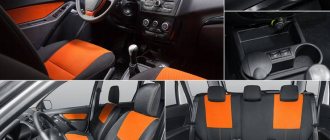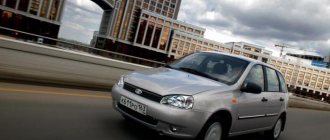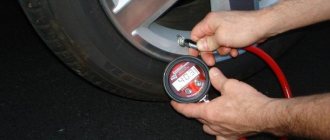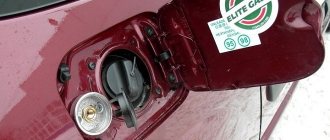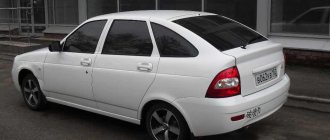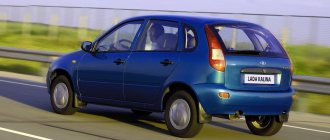Technical characteristics of Lada Kalina station wagon
| Car modifications | 1117 1.6 i | 1117 1.6 i 16V | 1117 1.4 i 16V |
| Engine | |||
| Engine location | Front transverse | ||
| Engine capacity | 1596 cm3 | 1390 cm3 | |
| Number of cylinders / Valves per cylinder | 4 / 2 | 4 / 4 | |
| Supply system | Distributed injection | ||
| Power (hp/rpm) | 80 / 5200 | 98 / 5600 | 90 / 5250 |
| Torque (Nm/rpm) | 120 / 2700 | 145 / 4000 | 127 / 4500 |
| Fuel type | AI-95 | ||
| Transmission | |||
| Wheel formula / drive wheels | 4X2 / front | ||
| Transmission | mechanical | ||
| Number of gears | 5 | ||
| Steering | |||
| Type | Rack type | ||
| Amplifier | There is | ||
| Brake system | |||
| Front brakes | Disk | ||
| Rear brakes | Drums | ||
| Suspension | |||
| Front suspension type | Shock absorber | ||
| Rear suspension type | Trailing arm | ||
| Body | |||
| Body type / number of doors | Station wagon / 5 | ||
| Number of seats | 5 | ||
| Length | 4850 mm | ||
| Width | 1700 mm | ||
| Height | 1500 mm | ||
| Front wheel track, mm | 1430 mm | ||
| Rear wheel track, mm | 1410 mm | ||
| Clearance | 160 mm | ||
| Trunk volume | 235 | ||
| Curb weight | 1080 | ||
| Permissible weight | 1555 | ||
| Performance characteristics | |||
| Acceleration time to 100 km/h | 14 s | 12.5 s | 12.9 s |
| Maximum speed | 170 km/h | 185 km/h | 165 km/h |
| Tire size | R14 175 / 65 | ||
| Fuel consumption urban cycle (l/100 km) | 10 | 9.5 | |
| Fuel consumption extra-urban (l/100 km) | 7 | 6.8 | 6,9 |
| Volume of the tank | 50 | ||
www.vazdriver.ru
Some owner reviews
Oleg, Ryazan. I didn’t want to have to deal with the Chinese for spare parts, but I didn’t have the money for more. I decided that Russian is still better for Russian roads. I took a Lada station wagon with 1.4 liters. The car, of course, is not sporty, but due to its low weight it is quite nimble, and the trunk is large. The mileage is already more than 150 thousand. On the highway it confidently maintains consumption of up to 7 liters. In the city cycle it reaches 10, although I drive carefully and don’t accelerate at traffic lights.
Nikolay, Samara. I drive a company car, but my wife got a Kalina hatchback with a four-speed automatic transmission. The car is good for a domestic car: the interior is comfortable, the appearance is nice, the assembly is standard. But I wasn’t pleased with the consumption. In the city it is stable 11 liters. This is a lot for such a car, especially since he told his wife to only fill it with 95-octane gasoline. I'll chip.
Sergey, Moscow. About 8 years ago I bought a two-year-old used Kalina, the owner sold it cheap. The car plows like a horse, I fill it with 92 and semi-synthetic, fortunately, the 8-valve allows it. From time to time I drive with a full trunk. I noticed: fuel consumption on the highway is on average 6.5, in the city it does not rise above 9 liters. Friends bought a new one in 1916, and it ate more than mine, even though the engine was new.
Weight of Lada Kalina station wagon. Technical characteristics of Lada Kalina Station wagon 1.6 MT
Technical characteristics of the Lada Kalina car
| Vehicle technical data | |||
| Body type | Sedan | Hatchback | |
| Number of seats | 5 | 5 | |
| Number of doors | 4 | 5 | |
| Curb weight, kg | 1080 | 1070 | |
| Total weight, kg | 1555 | 1555 | |
| Ground clearance (at full weight), mm | 158 | 158 | |
| Total weight of the towed trailer, kg: Equipped with brakes Not equipped with brakes | 900 450 | 900 450 | |
| Maximum speed, km/h | 170 | 170 | |
| Acceleration time to 100 km/h, s | 13 | 13 | |
| Fuel consumption per 100 km combined cycle | 7,8 | 7,8 | |
| Smallest turning radius, m | 5,2 | 5,2 | |
| Fuel tank capacity, l | 50 | 50 | |
| Transmission | |||
| Clutch - single disc, dry, with diaphragm pressure spring | |||
| The clutch release drive is cable, with an automatic cable length adjustment | |||
| Transmission – manual, five-speed, with synchronizers in all forward gears and with electric reverse gear locking | |||
| The main gear is cylindrical, structurally made in one block with the gearbox. Differential – conical, two-satellite | |||
| Gearbox ratios: 1st gear – 3.636 —— 3rd gear – 1.357 2nd gear – 1.950 —— 4th gear – 0.941 5th gear – 0.784 —— Reverse gear – 3.5 | |||
| Final drive ratio – 3.706 or 3.937 | |||
| Front wheel drive – Shafts with constant velocity joints | |||
| Chassis | |||
| Front suspension - independent, with telescopic shock struts, helical conical springs, lower wishbones, with braces and anti-roll bar | |||
| Rear suspension - semi-independent, with telescopic hydraulic shock absorbers, helical coil springs and trailing arms connected by a transverse beam | |||
| Wheels – disc, steel or alloy | |||
| Tire size – 175/70R13, 175/65R14, 185/60R14 | |||
| Steering | |||
| Steering mechanism – rack and pinion with electric power steering | |||
| Steering gear – Two rods with rubber-metal joints on the steering gear side and ball joints on the swing arm side | |||
| Brake system | |||
| Service brake system – hydraulic, dual-circuit – diagonal, with a vacuum booster and brake force regulator in the rear wheel brake drive | |||
| Front wheel brake – Disc, ventilated, with single-piston floating caliper and automatic clearance adjustment | |||
| The brake mechanism of the rear wheels is drum, with self-aligning pads and automatic adjustment of the gap between the pads and the drum | |||
| Parking brake – Manual, with a cable drive on the brake pads of the rear wheels | |||
| Electrical equipment | |||
| The electrical circuit is single-wire, the negative terminals of power supplies and consumers are connected to the body mass and the power unit | |||
| Rated voltage – 12 V | |||
| Battery – 6ST-55A, capacity 55 Ah. | |||
| Generator – alternating current, three-phase with built-in rectifier unit and electronic voltage regulator. Maximum output current – 85 A | |||
| Starter – DC, with planetary gearbox, electromagnetic traction relay and freewheel | |||
xn--44-6kchdmw3bgiawoo4b.xn--p1ai
Reasons for high fuel consumption on VAZ
Welcome, friends, to the DIY car repair website. Fortunately, not all car enthusiasts switched to foreign cars. There are also those who continue to successfully drive domestic VAZ cars. Why not?
Reasons for high fuel consumption
VAZ cars are very reliable, easy to maintain and unpretentious to fuel. But there is one problem that we constantly have to struggle with - increased “gluttony”.
Let's figure out what are the reasons for the high fuel consumption on the much-loved “classics” and more modern cars.
1. The air damper is not fully open. It is no secret that the normal position of the damper when the engine is warm is vertical. In turn, the position of the choke handle is “towards you”.
If the choke is pulled out completely, but the damper has not yet reached a vertical position, then the problem is obvious. The air-fuel mixture enters the combustion chamber too rich. As a result, consumption also increases.
Technical characteristics of Lada Kalina first generation
Lada Kalina is a car produced from the AvtoVAZ plant since 2004. During this time, engineers developed several body variations: sedan, hatchback and station wagon. Also, this VAZ model had a slightly different engine design: 8 and 16 valves. The transmission was also different: an automatic 4 and 5 speed gearbox, as well as a manual one, which also had 4 and 5 gears.
Body
The body of the Lada Kalina car has 4 or 5 doors, depending on its type: sedan or station wagon, respectively. The sizes are also slightly different. For example, the station wagon has a length of 4084 mm, which is 40 mm longer than the sedan body. The width and height, on the contrary, are absolutely the same: 1700 mm and 1500 mm, respectively.
Since the Lada Kalina sedan and station wagon are built on the same model, the wheelbase dimensions are absolutely identical. The difference may be clearance. The sedan body has slightly more ground clearance than the cargo version. This is due to the fact that the luggage compartment is designed differently and the weight that falls on the rear axle is also not distributed equally. For example, the trunk of a VAZ sedan is smaller in size and located at the rear, resting entirely on the rear axle. But the station wagon has a longer luggage compartment, which allows part of the load to be transferred to the front axle.
Hatchback dimensions
The trunk volume is very different for different body types of Lada Kalina. The sedan has a volume of 400 liters, while the station wagon has 670. This allows you to take on more weight, at which the ground clearance will not decrease significantly.
Factory wheel size can vary from R13 to R14. Depending on which wheels will be installed on the VAZ Kalina, the ground clearance will also depend. But at the same time, there will be one drawback: if you load a lot of weight into the trunk, the wheels will rub against the arch.
The maximum carrying capacity of the Lada Kalina station wagon is 400 kg, and the sedan is 200. The weight of the car without passengers is 1160 kg and 1080 kg, respectively.
Engine
On the VAZ Kalina, 2 types of cylinder heads were installed: 16 and 8 valve. The eight-valve engine was installed on all standard models and had relatively low performance. The design of such an engine was much simpler, and it was cheaper to repair or replace parts.
The maximum power of the 8-valve engine is 87 hp, at which Lada Kalina can develop a maximum of 168 km/h. Acceleration to the first hundred is in 12.2 seconds. But the 16-valve engine has as much as 106 hp. The maximum speed of the VAZ Kalina, with such power, is 181 km/h. Acceleration from hundreds - in 11 seconds.
Engine with a volume of 1.6 liters and a power of 98 hp.
Despite the completely different device, fuel consumption does not differ much. The 87-horsepower engine has 6.6 liters, and the 106-horsepower engine has 6.5 liters per 100 km. At the same time, the dimensions of the cylinders are absolutely the same - 1600 cubic centimeters.
Suspension
The Lada Kalina car was equipped with an independent suspension. Unlike the dependent one, it did not affect the ground clearance when the car moved over uneven surfaces. Each wheel, falling into a hole, or vice versa, driving over a hill, did not affect the other, located on the same axis.
The steering mechanism is rack-and-pinion, with gears. This is a pretty good solution for the VAZ Kalina station wagon, since at the same time the maneuverability of the car improved. Since the front axle carried not only the weight of the engine, but also part of the weight of the load, it often failed.
Bottom line
Lada Kalina is a pretty good car. It has a relatively light weight and acceptable dimensions. Fuel consumption, given the characteristics of an engine with 16 valves, is very low, which is good news. Relatively high ground clearance allows you to carry a fairly heavy load, about 400 kg. The dimensions of the wheelbase have a great effect on the stability of the car at speed. In a word, this VAZ model is worthy of competition to this day, even though it was released back in 2004.
vashalada.ru
Gasoline quality
If, after refueling at an unfamiliar station, it seemed that gasoline consumption had increased significantly, there is no doubt that this is so. This is usually due to the low quality of the fuel, which does not burn completely. As a result, engine power decreases. In order to continue moving at the same speed, you need to press harder on the gas pedal.
As a rule, experienced motorists immediately sense this and never return to the “problematic” gas station. In addition, when refueling in such places, you cannot insure yourself against underfilling. In the case when refueling occurs at the same station, and the feeling that the car has become more voracious does not leave you, you need to use the following method for measurement.
You need to wait until the fuel reserve light comes on, fill the Kalina to a full tank, save the receipt and reset the daily mileage meter. Without changing your driving style or thinking about saving money, you should continue traveling until the light comes on again. Using simple mathematical calculations, you can establish the average gasoline consumption and, if it turns out to be much higher than the passport value, continue searching for the cause.
LADA Kalina Cross – Technical characteristics – Official LADA website
- Body
- Wheel formula / drive...
- Engine location
- Body type / quantity...
- Number of seats
- Length / width / height (according to roof rails),…
- Base, mm
- Front/rear wheel track,…
- Ground clearance, mm
- Luggage compartment volume in passenger/cargo…
- Engine
- Engine code
- engine's type
- Supply system
- Quantity, location...
- Working volume, cubic meters cm
- Maximum power, kW (hp) / rev….
- Maximum torque, Nm / rev….
- Recommended fuel
- Dynamic characteristics
- Maximum speed, km/h
- Acceleration time 0-100 km/h, s
- Fuel consumption
- Urban cycle, l/100 km
- Extra-urban cycle, l/100 km
- Combined cycle, l/100 km
- Weight
- Curb weight, kg
- Technically permissible maximum weight...
- Maximum trailer weight without brake system /…
- Fuel tank volume, l
- Transmission
- Transmission type
- Main gear ratio...
- Suspension
- Front
- Rear
- Steering
- Steering gear
- Tires
- Dimension
www.lada.ru
Dimensions
Compared to previous VAZ models, the Lada Kalina has increased in size, which has a positive effect on the space in the cabin and the amount of luggage space in the trunk; the dimensions are noticeably larger. Note that the height, as well as the width, of the car remained unchanged, but the length increased noticeably.
It is these dimensions that now amount to 3.89 m. Let us recall that the width is 1.7 m and the length is 1.5 m. These are the dimensions of the car body. Another significant advantage of the Kalina is the ability to be equipped with an automatic transmission unit. The owners immediately appreciated this move, which allows the nimble Lada Kalina to “tolerate” city traffic jams well.
Let's touch on the body. For the practical “Russian”, the developers have provided an all-metal body frame.
The vehicle's curb weight reaches 1160 kg, and with full regulatory load it is 1560 kg. Moreover, we have already reported the dimensions of the body above, and they are not small.
We know the dimensions of the body, it’s time to talk about the dimensions of the luggage compartment Kalina now offers the owner a number of advantages. If you fold the back rows, the useful volume of space for placing cargo “grows” to 550 liters. Here, practical drivers will appreciate this solution, since they often have to transport items whose dimensions exceed the parameters of the trunk itself.
The station wagon modification has also grown significantly in size. The manufacturer has additionally equipped the roof of this body version with roof rails, which allows the owner to install an external luggage compartment for transporting large luggage.
The length of the station wagon exceeds 4 meters, which is longer in comparison with a hatchback or the same sedan. The width of the version remains unchanged - 1.7 m, which is also true for the height - 1.5 m.
Separately, we should touch upon the trunk of the station wagon, which has no competitors in the model line of all LADA Kalinas. Folding the backrests of the stern seats allows you to “increase” the volume of usable space to an incredible 670 liters for this class.
The fuel tank on the station wagon has been migrated from the sedan, which confirms the identical volume, capable of holding a maximum of 50 liters.
new-lada.ru
Lada Kalina station wagon - technical characteristics and solutions
The 1st generation Lada Kalina station wagon was shown in 2001. VAZ began producing this model in 2007. Modifications of the Lada Kalina hatchback and sedan were assembled since 2004. In 2013, the 1st generation VAZ Lada Kalina station wagon was discontinued.
Return to contents
Exterior and interior of a new car
Updated Kalina model
Before the release of the 2nd generation VAZ Kalina, the Grant sedan appeared, equipped with a new suspension, gearbox and engine. The transmission of this Lada model is an automatic mechanism. The top engine is a VAZ engine with 16 valves and passive supercharging. Its power is 106 hp. With.
The updated Lada Kalina station wagon 2 has an aggressive appearance. The similarity of the front part of the Kalina body of any modification, the unusual design of the rear door, the modernized bumper and optics are the main characteristics of the VAZ Kalina.
The dimensions of the station wagon are larger than those of the hatchback. The front part of the cabin remains unchanged. The rear is a loading platform (with the seats folded down). Multifunctionality, the presence of a central console, and a high-quality multimedia system are the main advantages of the 2nd generation station wagon's interior.
This model is equipped with electric power steering, airbags, and ABS. At the same time, the overall dimensions of the VAZ car remained the same. Taking into account the comments of car owners of the 1st generation Kalina, engineers eliminated the following shortcomings in the 2nd generation:
Therefore, the trunk of the second generation VAZ is slightly larger than in the first.
Return to contents
Technical equipment
VAZ Kalina station wagon 2 is equipped with 1.6-liter gasoline engines with a power of 87 hp. s, 98 l. s and 106 l. With. Cars equipped with the first or second engine are equipped with an automatic transmission from the Japanese company Jatco. Lada with a capacity of 106 hp. With. equipped with a modified classic manual transmission.
Comfortable car interior
Each gear shifts easily and has crisp action. The technical characteristics of the 2nd generation Kalina were influenced by the installation of a new suspension, which gives the car greater stability when cornering. At the same time, the ride comfort of this vehicle remains the same. If we compare the design and equipment of the VAZ station wagon and hatchback, they are on the same level. Their only difference is the length of the body.
The “Lux” version has a 16-valve engine. This unit is more powerful than its 8-valve counterpart, by 12 hp. s, which has a positive effect on the dynamics of the VAZ car. If a luxury station wagon is equipped with an automatic transmission, the dynamic characteristics of the car deteriorate slightly.
The fuel consumption of a 16-valve unit is less than that of an 8-valve unit. Competition between automatic transmission and manual transmission is observed only when driving on the highway. In other cases, more fuel is consumed. This indicator depends on the following factors:
- model year;
- transmission type;
- type of power unit;
- seasonality.
Return to contents
Features of modernization
AvtoVAZ engineers retained all the advantages of the Lada Kalina in the 2nd generation of the car, including a high seating position, good visibility, spaciousness and compactness. As for modernization, the engines are equipped with lightweight parts, which increases the power of the power units. The new engine design has a drawback - if the timing belt breaks, the valves collide with the pistons. The presence of a controlled start has a positive effect on the power (at high speeds) and traction (at low speeds) of the car.
The new Lada Kalina station wagon differs from its predecessor in excellent sound insulation of the interior and body. The engine compartment is protected from noise by higher quality, high performance materials. The 2nd generation Kalina is equipped with imported components made in Germany.
In terms of weight, a station wagon is on average 20-25 kg heavier than a hatchback. Dynamic performance is better in the old VAZ modification. If we compare the trunk volume, then for the 1st model this figure is 360 liters, and for the hatchback it is 261 liters.
A new power window control unit, a generator, a cooling, heating and ventilation system were installed in the car. There is no noise from the heater or fan in the cabin. Easy controllability and convenience during operation are ensured by the short steering rack installed on the Lada Kalina 2.
expertvaz.ru
conclusions
The first generation Kalina cars were equipped with the most common 8-valve petrol engine with a displacement of 1.6 liters. This unit was assigned the number 11183.
Vyacheslav1502
offline puki4 Regular chaser
Registration: 08/21/2016 Messages: 19 Address: St. Petersburg #3 puki4, 08/21/2016 22:09 we looked at the pump, it seems to be pumping normally, as the mechanic said. offline Stil Pro Diagnostic-electrician, mechanic
Registration: 04/01/2009 Messages: 8,935 Address: Russia, Krasnodar region village. Great #4 Stil, 08/21/2016 22:11 Message from puki4 : ^ seems to be pumping normally Click to expand. How much is this? offline Gudvin Veteran Auto Repair
Registration: 12/20/2009 Messages: 769 Address: Smolensk region. Desnogorsk #5 Gudvin, 08/21/2016 23:10 Message from puki4 : ^
Greetings ! Tell me about the problem, in general I bought a viburnum, there was a jamb with the receipt, I read the errors myself through elm327, the camshaft sensor and the detonation sensor showed an error, I replaced everything, there are no errors. In general, the owner said that the catalyst was cut out, when asked whether the car was flashed, he said “no”, but the check does not light up, the car is Euro 2, 1 oxygen sensor, they said it was working, in general it shows the consumption according to the on-board computer is 18 l/100 km, as be ? We cleaned the injectors, replaced the high voltage wires and spark plugs. We connected the computer, it shows 1.1 liters per hour at idle. When driving, it shows 11-13 liters of instantaneous consumption on the side of the viburnum, but also somehow intermittently, sometimes 6-7, sometimes 15, I don’t drive, it’s the 1st car. The car (Kalina 2006), the firmware seems to be the original I201CP57. The fuel is really running out ((
Click to expand.
I think you should go for a diagnosis. Otherwise, everything will work out for you, “it seems.” don’t trust the bortovik, this is a toy for car enthusiasts
Technical characteristics of Lada Kalina station wagon
| Modifications | 1117 1.6 i | 1117 1.6 i 16V | 1117 1.4 i 16V |
| Engine | |||
| Engine location | Front transverse | ||
| Engine capacity | 1596 cm3 | 1390 cm3 | |
| Number of cylinders / Valves per cylinder | 4 / 2 | 4 / 4 | |
| Supply system | Distributed injection | ||
| Power (hp/rpm) | 80 / 5200 | 98 / 5600 | 90 / 5250 |
| Torque (Nm/rpm) | 120 / 2700 | 145 / 4000 | 127 / 4500 |
| Fuel type | AI-95 | ||
| Transmission | |||
| Wheel formula / drive wheels | 4X2 / front | ||
| Transmission | mechanical | ||
| Number of gears | 5 | ||
| Steering | |||
| Type | Rack type | ||
| Amplifier | There is | ||
| Brake system | |||
| Front brakes | Disk | ||
| Rear brakes | Drums | ||
| Suspension | |||
| Front suspension type | Shock absorber | ||
| Rear suspension type | Trailing arm | ||
| Body | |||
| Body type / number of doors | Station wagon / 5 | ||
| Number of seats | 5 | ||
| Length | 4850 mm | ||
| Width | 1700 mm | ||
| Height | 1500 mm | ||
| Front wheel track, mm | 1430 mm | ||
| Rear wheel track, mm | 1410 mm | ||
| Clearance | 160 mm | ||
| Trunk volume | 235 | ||
| Curb weight | 1080 | ||
| Permissible weight | 1555 | ||
| Performance characteristics | |||
| Acceleration time to 100 km/h | 14 s | 12.5 s | 12.9 s |
| Maximum speed | 170 km/h | 185 km/h | 165 km/h |
| Tire size | R14 175 / 65 | ||
| Fuel consumption urban cycle (l/100 km) | 10 | 9.5 | |
| Fuel consumption extra-urban (l/100 km) | 7 | 6.8 | 6,9 |
| Volume of the tank | 50 | ||
vazclub.com
Description
Externally, the car meets all the requirements of modern fashion. The smooth contours of the body give it elegance.
The designers did a very good job on the headlights. The location of the rear lamps is good - they beautifully frame the trunk door.
The ground clearance of the Kalina Sport is quite high and amounts to 185 millimeters, the station wagon has a lower landing - 160, but this allows it to easily move over rough terrain and broken roads. The car drives through even large potholes smoothly and smoothly.
This allows you to transport bulky items. The trunk threshold is conveniently located - this makes loading and unloading as comfortable as possible.
Compared to the Kalina Priora, the station wagon, of course, has a more elegant interior design, but overall the first car is not much inferior in practicality and comfort.
Thanks to the wide doorways, it became very comfortable to sit in the cabin. The driver's seat is more ergonomic and the instrument layout is better than previous models. All buttons and control levers are located close to the steering wheel, and because of this it is not difficult to use them.
The manufacturer used high-quality plastic to make the interior panels. All elements fit well and do not make unnecessary sounds when moving.
The seats are comfortable, although their upholstery material looks, compared to foreign cars, rather poor and unpretentious. Both the driver and passengers have the opportunity to adjust the seat backs to suit themselves.
There is only one drawback - the driver's seat cannot be adjusted in height. But Kalina’s owners note that in general the review is already beyond praise.
The car is equipped with air conditioning. It is not difficult to control the air conditioning system, since the buttons are located on the instrument panel. Moreover, in the luxury configuration the car comes with a navigator.
Exterior
The appearance of the second generation Lada Kalina remained recognizable, but received a more harmonious, attractive and modern finish. The nose of the car is decorated with a hood with characteristic ribs, and there are also stylish lighting equipment with a darkened background and a massive front bumper with an air intake “mouth” and chrome decor (top trim levels also have fog lights).
The head optics flow smoothly into the narrow strip of the radiator grille. The bumper installed in front is of a relief type with a massive air intake in the center and has fog lights along the edge, which are covered with chrome “eyelashes”. True, we must admit that an air intake of this size does not fit perfectly with the overall design of the Lada Kalina 2.
Thanks to the smoothed body corners, the aerodynamic component has been improved, which has made it possible to reduce the noise of headwinds and make travel at high speeds more comfortable. If you look at the side of the car, you can see the presence of a sloping hood, a slightly sloping roof towards the rear, large door openings and large wheel arches.
All this together allows the hatchback to have a light and moderately dynamic silhouette. The fact that there are no stampings on the side body parts is made up for by the presence of door trims, which give the appearance of the car some relief against the background of the overall smoothing of the appearance. The wheel arches turned out to be a little swollen, and thanks to the high ground clearance of the hatchback, its solidity is felt.
The rear of the Lada Kalina 2 is compact and has beautiful lights, a neat luggage compartment lid and a small bumper with a plastic cover at the bottom, which serves as a protective option. As a result, the domestic new product looks quite good and fresh, and in terms of design it matches foreign cars.
the volume and overall dimensions of the body are described
When buying a car, for most people, not only technical characteristics are important, but also trunk volume. Moreover, with other similar parameters, it is the trunk volume that often turns out to be the decisive factor when choosing a specific car.
In 2013, the release of a new generation Lada Kalina was announced. And on May 16 of the same year, the first car with a hatchback body type rolled off the assembly line.
The car body has not undergone significant changes; the chassis has remained the same (the suspension has been slightly improved). As for the trunk volume of the Lada Kalina hatchback, according to the specifications, it is 240-550 liters.
What does this mean?
That with the rear seats installed, it is 240 liters, and if they are folded down, it will increase to 550. This volume is significantly less than the volume of the trunk of a Lada with a station wagon body (remember, this parameter was respectively 355/670 liters).
The trunk dimensions of the Lada Kalina hatchback are as follows:
- width – 947 mm;
- depth – 644 mm;
- height – 492 mm.
With the rear seats folded, the depth increases to 1319 mm, and if the trunk is left open, it can carry cargo up to 1277 mm in size.
As you can see, for a small family this car is even suitable for traveling, and if you only use it for commuting to work and visiting, then the relatively lower cost (compared to the same “station wagon”) makes it a more profitable option for purchase.
myhatch.me
Maintenance
According to AvtoVAZ recommendations, the 11183 engine must be serviced according to the regulations:
| Oil consumption | 0.5 l/1000 km |
| Engine oil for 11183 | 5W-30 and 10W-40 |
| Engine oil volume | 3.5 l |
| Operating temperature | 95° |
| Motor life | declared 150,000 km, |
| Adjustment of valves | washers between camshaft cams and tappets |
| Cooling system | forced, antifreeze/antifreeze |
| water pump | plastic impeller |
| Candles for 11183 | BPR6ES, A17DVRM |
| Gap between spark plug electrodes | 1.1 mm |
| Timing belt | Gates |
| Cylinder operating order | 1-3-4-2 |
| Air filter | Nitto, Knecht, Fram, WIX, Hengst |
| Oil filter | catalog number 90915-10001 |
| Flywheel | from 2110 |
| Valve stem seals | code 90913-02090 light inlet |
| Compression | cylinder pressure from 13 bar nominal |
| XX speed | 800 – 850 min -1 |
| Tightening force of threaded connections | spark plug – 18 Nm |
| Maintenance object | Time (month) or mileage (10,000 km) |
which comes first
Malfunctions
Motor 11183 is characterized by malfunctions that are typical for all power units produced by AvtoVAZ OJSC.
| FAULTS | CAUSES | REMEDY METHODS |
| The engine does not warm up to the required temperature. | Thermostat is faulty. | Replace thermostat. |
| Knocking and noise in the engine. | 1. Valve clearances are not adjusted. 2. Wear of the crankshaft main bearings. 3. Wear of connecting rod bearings. 4. Pistons knock | Adjust valve clearances. Malfunctions associated with wear of bearings and the need to replace pistons are recommended to be repaired in a specialized car service center. |
| The engine operates unstably (“speeds float”, “troits”, etc.) | 1. The throttle position sensor is faulty. 2. The valve has burned out. 3. The gasket is broken. 4. The ignition module is faulty. | ŸReplace the faulty sensor. Measure compression in cylinders. If it is below normal, then the malfunction is hidden in the gas distribution mechanism. If compression is normal, the fault must be looked for in the ignition module. |

